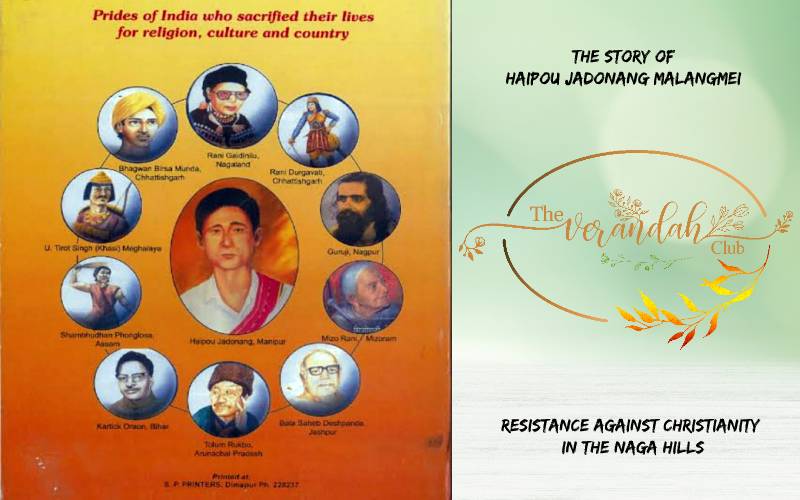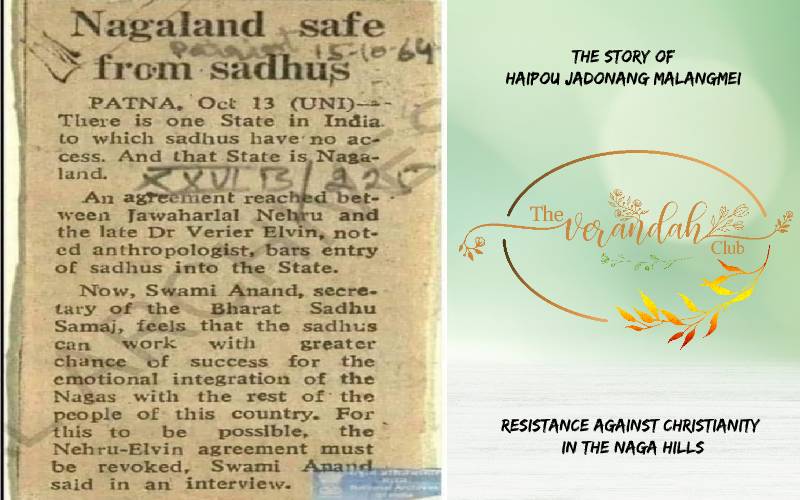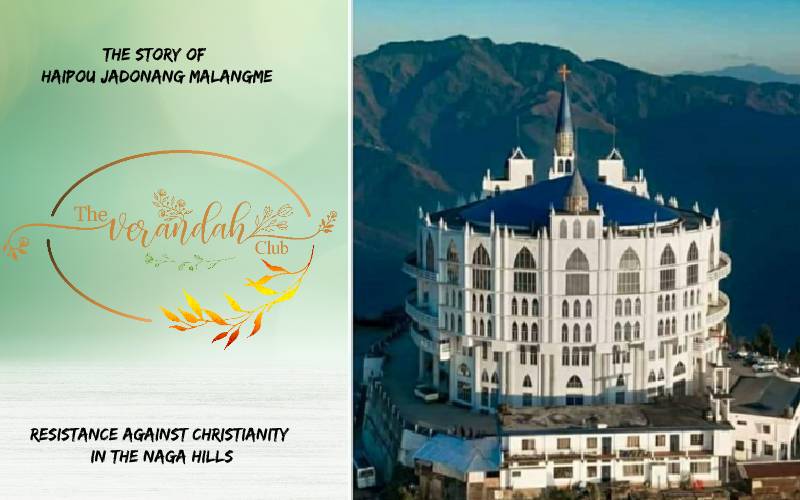
The Story of Haipou Jadonang Malangmei
Haipou Jadonang Malangmei, forgotten son of Ma Bharati and a freedom fighter from the Naga Hills of Poorvottar Bharat, not only fought against the British colonialists but also Church-led religious proselytisation. He belonged to the Rongmei community of the Nagas which falls under Zeliangrong that represents a combination of four cognate groups – Zemei, Liangmei, Rongmei, and Inpui. The Nagas have had their own religious belief systems predating other religions, including Christianity. It was in the early 1920s that Christianity had started making significant inroads into the then princely state of Manipur, which was almost wholly Vaishnavite at that time, and its neighbouring areas.
Jadonang was one of the first persons who claimed himself to be the Guru of the people of his community with the objective of liberating them from the clutches of the British. He was aware of the Kuki Rebellion (1917-19) and had seen the movement of the British platoons in his village. Respected widely in the community for his spiritual and healing powers, Jadonang’s religious and social activities increasingly became popular among the masses which naturally irked the British.
Haipou Jadonang was born in 1905 in a poor peasant family at a remote village called Kambiron (Puilion) to Thiudai Malangmei (Father) and Tabonliu (Mother). This place is situated in present-day Tamenglong district of Manipur, on the Bengal-Manipur-Cachar road. Young Jadonang and his elder brother Mudunang closely watched the movement of soldiers, officials, and traders of Manipur through this road. Their dubious activities such as the forcible collection of house tax, the oppressive porter system, and the missionaries’ preaching about the Gospel of Jesus, etc. left a deep impression in the mind of young Jadonang.
Jadonang felt that the rising proliferation of Christianity was an instrument of British imperialism to weaken the societies and their native religious systems from within. Driven by necessity, many Zeliangrong families had converted into Christianity, hoping that their appeasement of the British would somewhat lessen their economic burdens. It was towards his late teens and early adulthood that Haipou Jadonang’s ideas about the revival of indigenous Naga culture, political struggle of the Nagas against the British, social change, etc. gradually began to take shape.
Haipou Jadonang had a unique and extraordinary childhood to which his mother was a close witness. He visited places like the Zeilad Lake in Manipur (A centre of spiritual and religious importance for the Nagas) where he used to go into deep meditation for several days at a stretch. He came back with miraculous powers of foretelling the future that drew many people into his fold. He also popularised the use of various local herbs and medicines as healing agents for treating the sick who had come to him seeking a cure for their illnesses.

Kambiron soon transformed into a prominent place of pilgrimage for those in need and the centre of attraction was the charismatic, young Jadonang. The people of Kambiron looked upon Jadonang as Mhu, meaning, a spiritual guide, healer, and preacher. He was officially declared as the Mhu-Ren after the observance of a ceremony called Ralen-Loumei, i.e., worship of all the local deities of the Zeliangrong Naga pantheon including Lord Vishnu. It was after this ceremony that Jadonang, along with a few other pilgrims, went to the pre-historic Bhuvan cave near Silchar, Assam. Here, they worshipped Bhagwan Vishnu, and another local deity called Tingkao Ragwang, who was believed to be the supreme deity residing in the cave.
The Bhuvan cave gradually became a sacred spot where it is believed that Haipou Jadonang personally communicated with Bhagwan Vishnu. It was during his frequent visits to the cave that he came into close contact with the Rongmei Naga settlers of Cachar district in Assam. Thereafter, he used to visit almost all the villages in Cachar treating the sick, praying for the dead, and interpreting people’s dreams. The Zeliangrong Nagas had looked upon Vishnu as the chief deity of welfare and all-round prosperity of men and all other living beings in the universe. In the Zeliangrong pantheon, Bhagwan Vishnu is known by different names such as Monchanu, Bonchanu, Bisnu, Buisnu, etc.
It was after his spiritual journey to the Bhuvan cave that Jadonang erected an east-facing temple called Rah Kai (House of God) with the help of his followers, chiefly as a place for worship and religious discourse. The locals here worshipped the deity of Tingkao Ragwang through hymns, devotional songs, and dances, etc. that were introduced by Jadonang himself. The temple was erected by Jadonang towards the east for it signified the direction of the Bhuvan cave and as well as that of sunrise. All these gradually led to the introduction of two new religious faiths – Tingkao Ragwang Chapriak (TRC) and Heraka (Pure religion) under the moral guidance of Jadonang and his cousin, Haipei Rani Gaidinilu, another brave female Naga spiritual leader, respectively. It represented a significant landmark in the cultural and religious history of the Zeliangrong people.
Heraka is a monotheistic cult which believes in the worship of only Tingkao Ragwang (The Supreme Being), incorporating the lesser gods and deities within its fold. Tingkao Ragwang Chapriak, on the contrary, is based on polytheism or the worship of multiple gods and goddesses, although it places supreme emphasis on the worship of Tingkao Ragwang. The evil spirits (Rahsi-Rahrou) are not worshipped but they are propitiated to save humanity from their trouble. With the help of these cults, Jadonang, together with the support of Gaidinliu, was not only able to bring about a social unification of the Zeliangrongs, but also posed a formidable challenge to the silent religious aggression of the Christian missionaries. However, it is to be noted here that these new cults of Jadonang and Gaidinliu did not, in any way, preach or promote anti-Christian teachings.

Increasing Christian proselytisation activities became a serious issue for Jadonang who wanted to preserve and promote the traditional religious beliefs and practices of the locals. He was quick to realise that if the traditional religion was to be saved, the morass of superstitions and irrational taboos that afflicted it had to be removed and new ideas introduced in their place to keep pace with the changing needs of the times. He organised his people against religious conversion programmes of the missionaries by encouraging the construction of mandirs called Karumkai that were adorned with several images of the python in the Zeliangrong-dominated areas.
He travelled across lands inhabited by his fellow Nagas, seeking support for his political leadership. It is said that he would often travel on horseback wearing formal British attire to avoid detection. However, the British officials got a wind of it in 1928, and S. J. Duncan, the then Sub-Divisional Officer (SDO) appointed by the British, confronted Jadonang one day while asking him to dismount himself from the horse and remove the hat that he was wearing. Jadonang refused, and so he was taken to Tamenglong, where the British interrogated him and ordered him to spend a week in jail.
The news of Jadonang’s arrest coincided with the arrival of the Simon Commission in India. It increased his mass popularity further. Jadonang decided to militarily challenge the might of the British Empire after his release from jail. He therefore organised the Heraka (Riphen) that also consisted of a separate battalion for women under the leadership of Rani Gaidinilu. It was extremely well-trained in local military tactics such as spear-hurling, gunpowder-making, etc. handling of weaponry and conducting reconnaissance missions. Armed with weapons, personnel, and an innate understanding of the local terrain, it also assisted the civilians in their day-to-day livelihood activities such as farming, livestock rearing, and firewood collection, among others.
Jadonang was deeply inspired by M.K. Gandhi’s call for ‘Satyagraha’ and ‘Civil Disobedience’. After 1930, he gradually intensified his activities against the colonial state and the Church. He appealed to his people to stop the payment of all forms of taxes immediately. This offended the British Government more and it now came to recognise Jadonang and his activities as an open threat to their authority and legitimacy in the North-East. Following the order of J. C. Higgins, the then political agent of Manipur, Jadonang was subsequently implicated and arrested on a false charge of murder of four Manipuri betel-leaf traders.
On August 29, 1931, at the young age of merely 26 years, Jadonang was hanged till death in full public view by the orders of the British Government on the banks of the Nambul river behind the Imphal Jail. He embraced death fearlessly. Haipou Jadonang is still revered as a great saint and socio-religious reformer among the Nagas of Assam, Manipur, and Nagaland. Every year, August 29 is commemorated as his death anniversary, especially in the Zeliangrong inhabited areas of these states, with patriotic songs, dance, and festivities.

(The author holds a PhD in Political Science and regularly writes on the culture, politics, society and history of Poorvottar Bharat).
NEXT ARTICLE

At the southernmost tip of this mesmerising ensemble lies the majestic Great Nicobar Island, boasting an impressive landmass of about 910 square kilom...

Bharath has always been a land traversed by spiritual masters/ Guru since time immemorial. These spiritual masters have always upheld the core princip...

South India contains its fair share of unique pilgrimage centres. These divine places of worship have a prominent Sthala Purana, devoted followers, di...